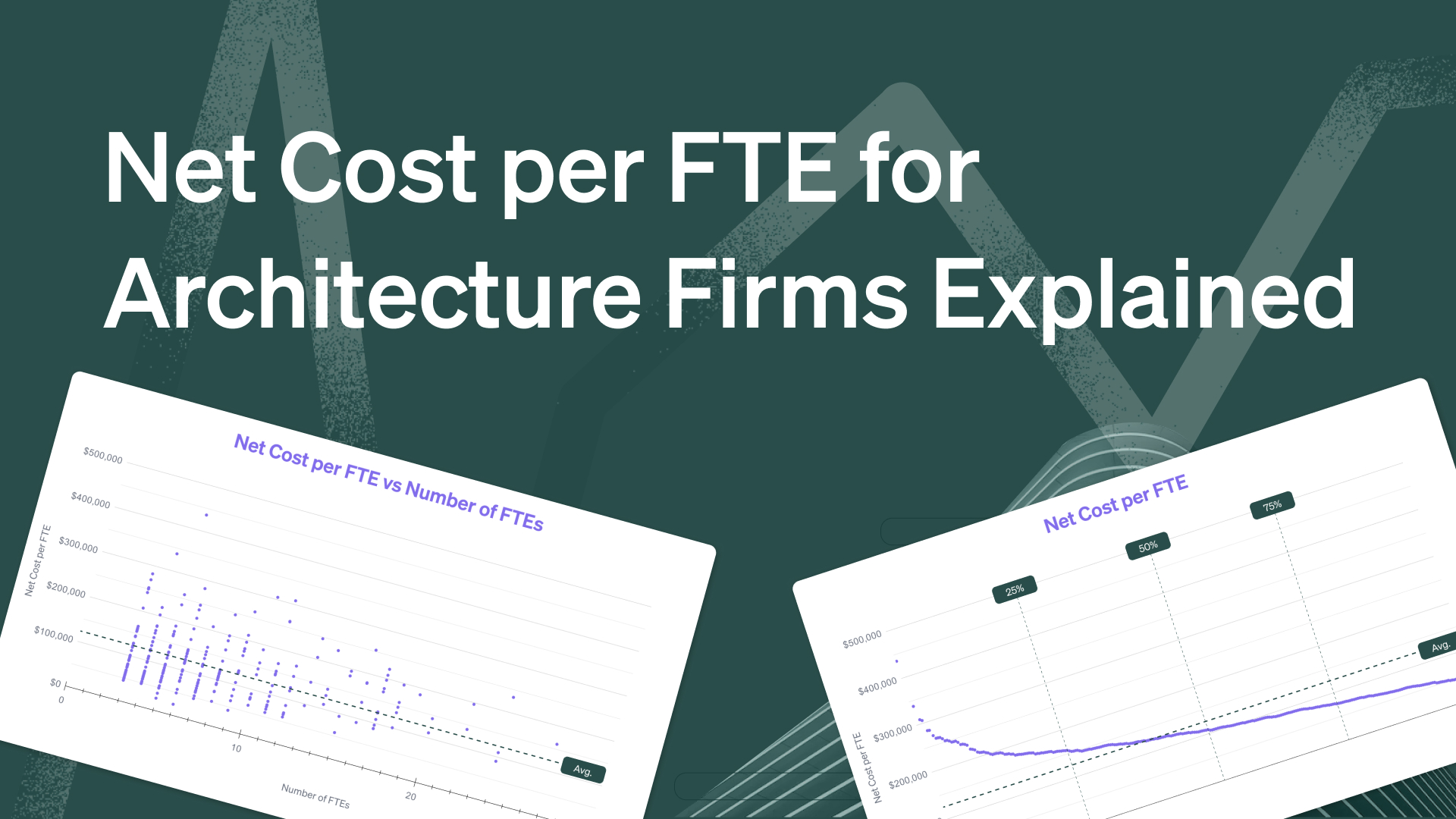Contents
Understanding and optimizing realization rates is crucial for the success of every architecture firm. Realization rate is a metric that could very well dictate the financial health of an architecture firm. It's not just about the hours spent sketching and planning; it's about ensuring those hours translate into tangible revenue.
"Realization Rate is a metric I encourage all firm owners to focus on as getting paid for all of the work your team puts into projects should be a baseline expectation. Realization Rate is a clear indication of whether you are earning the right revenue compared to effort, and it shines a light onto your team’s operational efficiency. Further, it can be an indicator of whether you have enough billable work for the size of your team."
- Lucas Gray, Director of Business Development & Senior Business Consultant at Charrette Venture Group
Realization Rate, along with four other crucial business metrics, is covered extensively in Monograph's 2024 Architecture Business Benchmarks Report. This guide aims to summarize details and demystify the concept of Realization Rate for architects and business managers alike. We'll explore what it means, how it's calculated, and why it's a critical component of your firm's financial strategy. Through comparative insights and practical advice, we aim to equip you with the knowledge to assess and enhance your firm's Realization Rate, ensuring a more profitable and sustainable business model.
So, let's dive in and unlock the potential that lies in understanding and optimizing your Realization Rate, paving the way for a healthy architectural practice.
Decoding Realization Rate: What it means for architects
Here, we'll explore what Realization Rate really means for architects, how you can calculate it, and why it's so important for the health of your business. It's all about making sense of the financial side of your work in a straightforward way.
What is Realization Rate?
Realization Rate, also known as Billable Ratio, measures the percentage of billable work that is actually charged and invoiced to clients. It reflects the effectiveness with which a firm converts its billable hours into revenue.
For example, if your firm logs 1,000 billable hours in a month and succeeds in invoicing 900 of those hours to clients, your Realization Rate would be 90%. This means you've managed to convert 90% of your potential billable work into actual revenue, reflecting a strong ability to capture the value of the work your team performs.
This metric indicates not only the productivity of the staff but also the firm's ability to effectively charge for its services.
This is not to be confused with Utilization Rate, which is the proportion of billable hours worked compared to total hours worked.
How is Realization Rate calculated?
Realization Rate is equal to the total billed service fees divided by the total billable service fees.
Why is Realization Rate important for architects?
Realization Rate is an indicator of financial health. A high realization rate suggests that the firm is successful in converting its billable hours into revenue, indicating efficient staffing and billing practices and effective client relationships. Conversely, a lower rate may signal issues like excessive write-offs, underbilling, or inefficiency in the billing process.
Realization Rate helps identify areas for improvement in your billing process and project management, ensuring that you're maximizing the potential revenue from each project. By keeping a close eye on this metric, you can make informed decisions about pricing, workload distribution, and overall business strategy.
Comparison of Realization Rates in architecture firms
So what benchmarks should you be aiming for? How do your firm's Realization Rates stack up against the industry standard? The latest findings from the 2024 Architecture Business Benchmarks Report offer a deep dive into Realization Rates across the Architecture and Engineering (A&E) industry, providing a clear picture of where you stand.
Average Realization Rate for architecture firms
Setting the right expectations for your firm’s Realization Rate is crucial, and now, thanks to the 2024 Architecture Business Benchmarks Report, there's concrete data to guide you.
Across the board, the report indicates an average Realization Rate of 91.3% for architecture firms.

This figure is pivotal as it signifies the overall efficiency at which firms are converting billable hours into actual invoiced revenue.
Top and bottom Realization Rates for architecture firms
Delving into the details, the variance in Realization Rates across firms is telling.

- The top quartile of architecture firms boasts a remarkable average Realization Rate of 103.9%, illustrating not just efficient billing practices but also effective fee models.
- Conversely, firms in the bottom quartile see an average Realization Rate of 76.5%, highlighting areas for improvement in billing efficiency or project management.
- The median Realization Rate, sitting close to the average at 91.5%, suggests a strong central tendency towards high efficiency in Monograph users.
How can architecture firms achieve a Realization Rate above 100%?
Curious as to how the top quartile of architecture firms using Monograph achieve a Realization Rate above 103%? A Realization Rate over 100% is achievable when firms employ a Fixed Fee arrangement for their projects. This model sets a predetermined fee for the entire project, regardless of the actual hours spent.
When a firm efficiently manages a project to completion using fewer billable hours than initially anticipated, while the agreed-upon fee remains unchanged, the result is a Realization Rate that can exceed 100%. This indicates not just efficiency in project delivery but also an effective strategy in negotiating and managing project fees.
Firms in the top quartile often leverage such billing models to their advantage, aligning project management practices and client agreements in a way that maximizes revenue potential beyond the conventional 1:1 ratio of billable hours to invoiced amounts. This approach underscores the importance of strategic planning, efficient project execution, and skillful financial management in achieving superior financial performance.
Focusing on Realization Rates can drive innovation and efficiency. As firms invest in training, new tools and technologies, and making their systems and processes more efficient, coupled with fixed price contracts they should see realization rates climb steadily and ultimately lead to drastically increased profitability. I like to see the firms I consult with be in the 90-100% range, but also point out that it is possible to overachieve and realize over 100% of the value of the billable effort.
- Lucas Gray, Director of Business Development & Senior Business Consultant at Charrette Venture Group
Why do Monograph users have high Realization Rates?
It's worth noting that the figures shared here and in the 2024 Architecture Business Benchmarks report are based on accurate, first-party data from Monograph users. Notably, the Realization Rates for firms that use Monograph are higher than what is generally recommended. Why is that?
Monograph, a project management tool designed exclusively for architecture and engineering firms, enhances firms' ability to track billable hours accurately and streamline the invoicing process. The platform's intuitive design and focus on the specific needs of the A&E industry mean that firms using Monograph can often reduce the time spent on administrative tasks, increase the hours available for billable work, and streamline billing processes. Not to mention that the visibility into these metrics, as provided my Monograph, enables firms to more confidently estimate project fees and use fixed fee models that create Realization Rates above 100%.

Altogether, these factors contribute to a higher Realization Rate than what is generally experienced by architecture firms that aren't using Monograph.
For a deeper dive into these figures and more insights on enhancing your firm's performance, accessing the full 2024 Architecture Business Benchmarks Report is highly recommended. It’s an invaluable resource for any firm looking to evaluate its financial acumen and operational efficiency.
How can architects improve Realization Rate?
Improving the Realization Rate is a multifaceted endeavor that hinges on strategic adjustments in both fee models and operational efficiencies. Let's delve into how varying fee models can impact your Realization Rate and how you can improve your firm's Realization Rate.
How fee models impact Realization Rate
The structure of your fee model plays a pivotal role in determining your Realization Rate. Traditional models like hourly billing can offer straightforward correlations between work performed and revenue earned but might limit your potential for higher realization if not managed meticulously. On the other hand, the Fixed Fee model, as mentioned, provides an opportunity to surpass 100% Realization Rates by completing projects more efficiently than the allocated budget allows. Adopting a Value-Based Fee model is another strategy, where fees are determined by the perceived value to the client rather than just hours spent, potentially leading to higher realization rates through better alignment of project outcomes with client satisfaction.
Each model carries its own set of challenges and opportunities for improving your Realization Rate. The key is to match the project and client with the most appropriate fee structure, ensuring clear communication of expectations and deliverables. Additionally, implementing project management and time tracking tools can provide the data and insights needed to optimize your approach, leading to more strategic decisions around billing and project execution.
5 ways architects can improve Realization Rate
Here are several strategies that architecture firms can engage in order to increase Realization Rate:
- Ensure accurate time tracking and billing practices to capture all billable work.
- Regularly review contracts and scope of work agreements to minimize discrepancies between billed and billable hours.
- Improve client communication to ensure clarity in billing and to reduce the likelihood of disputes and write-offs.
- Streamline the invoicing process to ensure timely and efficient billing.
- Track pace against fees to avoid going over budget on projects that don't allow for additional fees.
Next steps
As we've explored throughout this article, understanding and optimizing your Realization Rate is fundamental to enhancing the financial health and operational efficiency of your architecture firm. We've covered what Realization Rate means, how it's calculated, its significance, and the strategies for improving it, including the impact of different fee models and the broader implications on business performance.
Remember, the insights and benchmarks provided in the 2024 Architecture Business Benchmarks Report are invaluable tools for assessing where your firm stands and identifying areas for growth and improvement. If you're motivated to improve your firm's performance and ensure its success in the competitive landscape of architecture, downloading the 2024 Architecture Business Benchmarks Report is an essential next step. It's filled with comprehensive data and insights tailored to help you make informed decisions and strategic adjustments.
Moreover, for those looking to dive deeper and truly transform their firm's operational dynamics, consider booking a meeting with Monograph. Our platform is designed specifically for architecture and engineering firms, providing the tools and insights needed to streamline project management, optimize billing practices, and ultimately, improve your Realization Rate.
Monograph is here to support your journey toward greater efficiency, profitability, and success!




